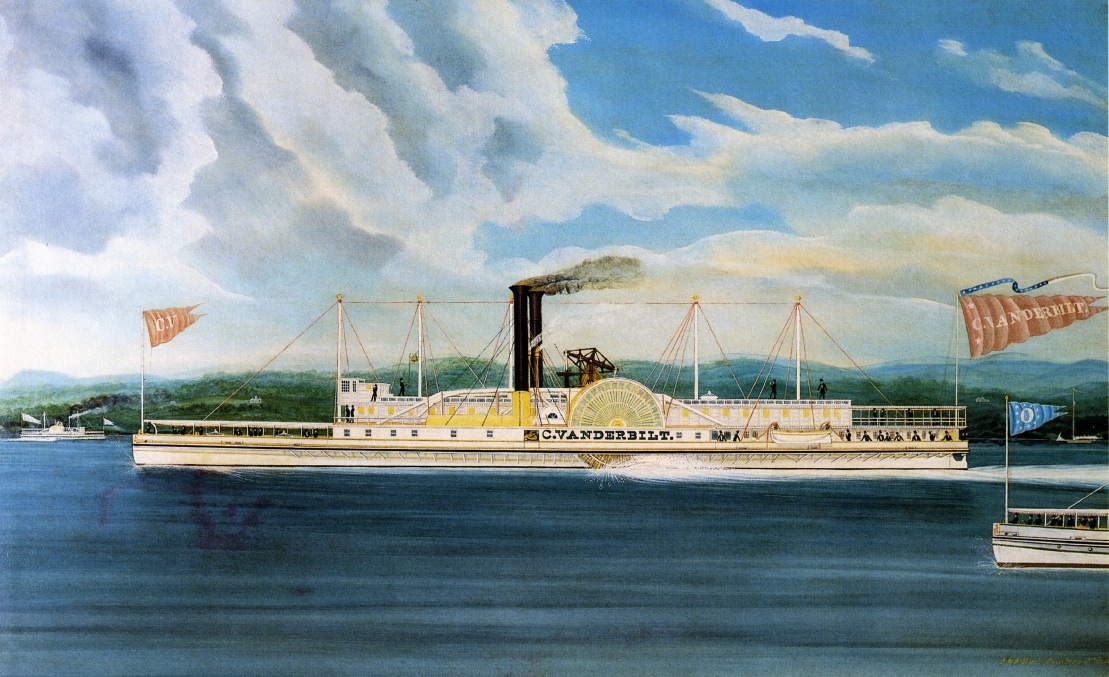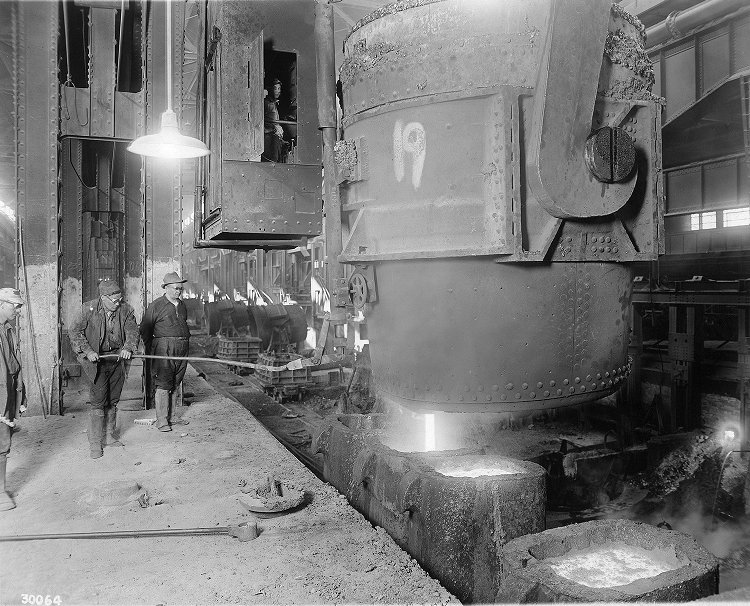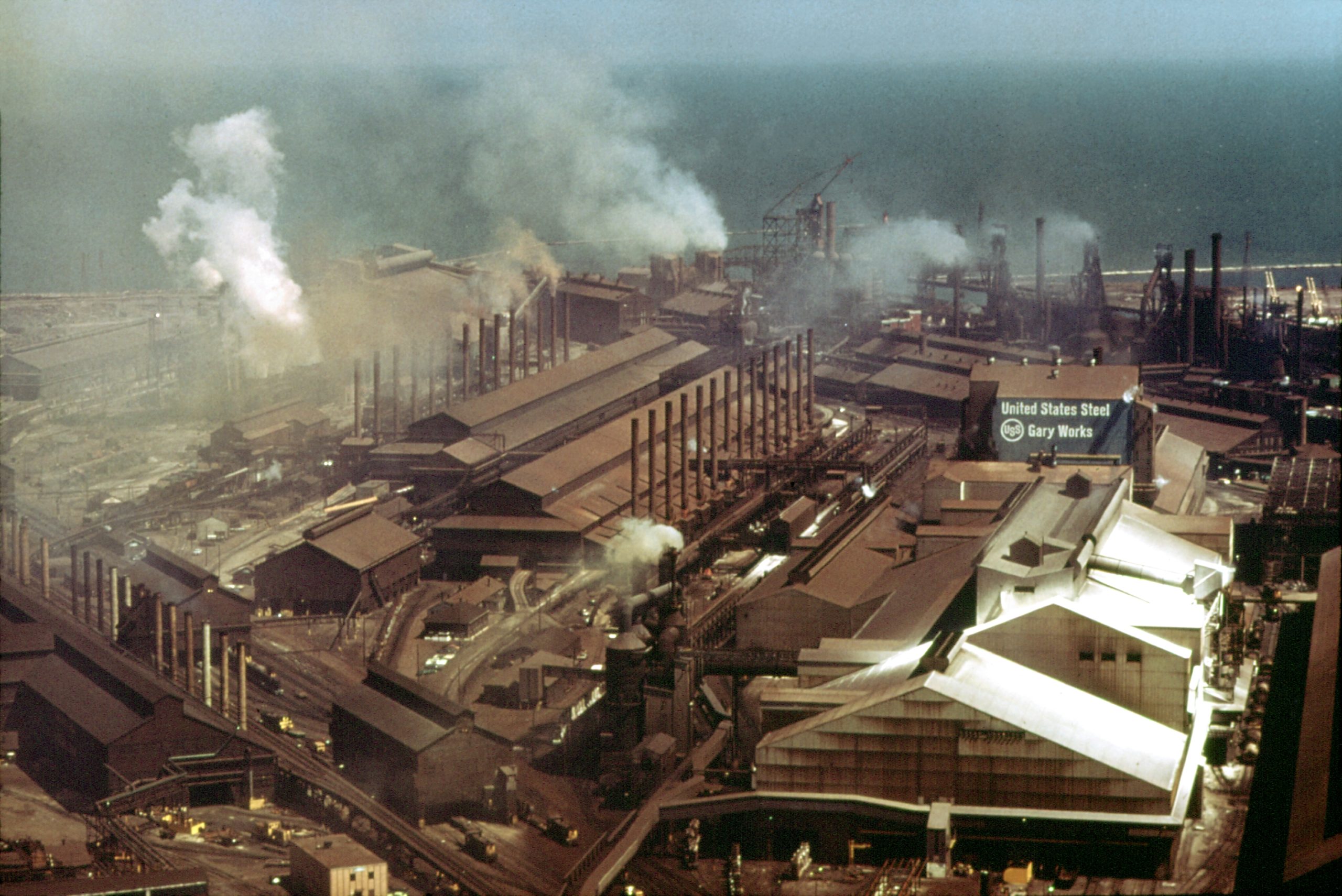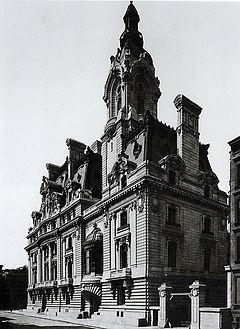INTRODUCTION
The great industrialists of the Gilded Age remade America. They made money by building railroads, skyscrapers, and bridges with their own steel and powered the industrial revolution with oil. This is why they are respected and the small number of men who led the industries of the time are called captains of industry.
The captains of industry had another name: robber barons. People who saw how they controlled their workers and paid off politicians called them this name.
This lesson is an introduction to a few of the great industrialists. It is up to you to decide. Were they captains of industry who helped make America great, or robber barons who hurt America and everyday people?
CORNELIUS VANDERBILT
Cornelius Vanderbilt was the first great American industrialist. He was born in New York in 1794, which was two years before the Declaration of Independence was signed. Growing up without much education, Vanderbilt went to work in the shipping industry. Nicknamed “The Commodore” he started and controlled many transportation companies.
His first steamships were successful because people needed to move a lot of products during the time of the California Gold Rush and the Civil War. After the Civil War, Vanderbilt started buying railroads. He formed the New York Central Railroad. His railroad station in New York City is still one of the largest railroad stations in the world.
As he grew older, he started a tradition of philanthropy, or giving away his money, that other industrialists copied. With his money, he started Vanderbilt University in Nashville, Tennessee.
After some time, Vanderbilt’s grandson used the family money to build one of America’s largest private homes, the Biltmore Estate.
 Primary Source: Painting
Primary Source: Painting
Vanderbilt’s steamship, which he named after himself.
ANDREW CARNEGIE
Like other industrialists, Andrew Carnegie was not born rich. When he was 13, his family came to the United States from Scotland and stayed in Allegheny, Pennsylvania, a small town near Pittsburgh. His first job was in a cotton mill, where he earned $1.20 per week.
His bosses saw that he was talented and made Carnegie the bookkeeper of the business. A passionate reader, Carnegie spent his Saturdays in the libraries of rich people’s homes. After he got a job as the personal secretary for the boss of a railroad company.
In the Gilded Age, the country needed steel. The railroads needed steel for their rails and cars, the navy needed steel for their new ships, and cities needed steel to build skyscrapers. Every factory in America needed steel for their buildings and machines. Andrew Carnegie saw this need for steel and knew it was his chance to be great.
 Primary Source: Photograph
Primary Source: Photograph
Inside Carnegie’s Homestead Steel Mill near Pittsburg, Pennsylvania.
Carnegie became a great industrialist because of his smart business ideas. Rockefeller often bought other oil companies to get rid of competition. This is called horizontal integration. Carnegie also used vertical integration which was when he bought railroad companies and iron mines. If he owned the rails and the mines, he could lower his costs and make cheaper steel.
Carnegie was good at noticing other people’s talent. Carnegie’s assistant, Henry Clay Frick, helped make the Carnegie Steel Company successful. Carnegie wanted hard workers who wanted the company to be successful, so he made a retirement plan that shared the money the business made to the workers.
Carnegie’s actions made the Carnegie Steel Company successful. In 1901, he sold his company to J.P. Morgan, who paid him $500 million and renamed it U.S. Steel.
ANDREW MELLON
Andrew Mellon was a son of a banker and a judge. Ever since he was young, he was very good at investing and banking. In 1872, he made the coal and lumber business his father gave him successful. In 1889, he joined his father’s banking business called T. Mellon Sons. Two years later, his father gave him the bank. In 1889, Mellon helped put together the Union Trust Company and Union Savings Bank of Pittsburgh. He also branched into industrial activities: oil, steel, shipbuilding, and construction.
Mellon helped make many different companies successful. Mellon gave money to Charles Martin Hall who started the Aluminum Company of America (Alcoa).
He made a new industry by helping Heinrich Koppers who invented coke ovens. These coke ovens turned industrial trash into things that can be used to make steel. Mellon also invested, or gave money to, the New York Shipbuilding Corporation.
By the end of his life, Mellon was one of the richest people in the United States.
Andrew Mellon worked in government too. In the 1920s, he was the Secretary of Treasury when Harding, Coolidge and Hoover were president.
Like Carnegie, Mellon also gave away a lot of his money. Carnegie-Mellon University was built using Carnegie and Melon’s money. Mellon also gave money to set up the National Gallery of Art in Washington, DC.
J. PIERPONT MORGAN
Not all the rich people in the Gilded Ages started off without money. J. Pierpont Morgan was born into a rich family. His father was a famous banker. Morgan used his family’s money to go to good schools so he could learn about business.
He had an easier time getting started than some of the other industrialists because his father got him a job at one of New York’s finest banks. Morgan himself had a great mind of his own and set out to take control of the banking world.
During the Civil War, Morgan made a lot of money selling things to the government and the army. After the war, he decided he wanted to control the country’s financial markets. When the Panic of 1973 destroyed the country’s wealth and resources, Morgan was smart enough to protect himself and became the king of American finance.
Although he was called a robber baron, Morgan believed his investments helped America. His railroad dealings helped put together many smaller, badly managed companies. The result was that people could take shorter trips and service was better. During financial panics, he allowed the government to buy a lot of his gold which stabilized prices.
He owned a bridge company and a tubing company. In 1901, he bought the Carnegie Steel Company for $500 million to create the U.S. Steel. In ten years, U.S. Steel was worth over a billion dollars.
 Primary Source: Photograph
Primary Source: Photograph
The Homestead steelworks. It was the center of Carnegie Steel and the U.S. Steel after J.P. Morgan purchased the company.
Morgan showed that you don’t have to be a builder to become successful. Smart investments can lead to making big money. Young entrepreneurs changed their goals to banking in hopes of copying Morgan’s success.
For all that he did well, some people still didn’t like him, especially some people in the government. His railroad was found to be illegal under antitrust law. Then Congress questioned him about his control of the financial markets. They even forced him to give up control of U.S. Steel.
As a result of criticism, Morgan moved to Europe at the end of his life. People always used Morgan as an example of how the rich stole money from the poor, but he was an inspiration to enterprising financiers that wanted to be like him, unless they were destroyed by him!
By the time of his death, J.P. Morgan owned or partly owned many railroads, General Electric, the American Bridge Company, and an investment bank that still exists in the form of MorganStanley.
JOHN D. ROCKEFELLER
He was America’s first billionaire. The goal of any capitalist is to make money and John D. Rockefeller wanted to be the richest person in America.
In the beginning of a new century, while an average worker earned $8 to $10 per week, Rockefeller made millions of dollars.
There are many different ways to think about Rockefeller, but we should always remember how he changed America’s economy.
Rockefeller was born in 1839 in Moravia, a small town in western New York and started working as a clerk in a Cleveland shipping company. He saved enough money to start up his own company buying and reselling products. When the Civil War came, everyone wanted his items and Rockefeller started getting rich.
When Edwin found oil in 1859 in Titusville, Pennsylvania, Rockefeller saw an opportunity and focused on making oil a useful product that he could sell.
Rockefeller changed the oil industry. In the mid-19th century, everyone wanted kerosene. Rockefeller refined oil from the ground into kerosene. But what Rockefeller did that was new was to find ways to use and sell the byproducts, or leftovers of the oil after the kerosene was made. He sold paraffin to candle makers, petroleum jelly to medical supply companies and even sold tar to people making roads. He was so successful that railroad companies drooled over the dream of getting his business.
 Primary Source: Photograph
Primary Source: Photograph
John D. Rockefeller at the height of his power and influence. In later years he turned control of his company over to his sons and lieutenants. He became an avid golfer and retired to Florida.
Years later, John D. Rockefeller gave his company to his sons and lieutenants. He became an avid or enthusiastic golfer and retired to Florida.
Rockefeller wanted rebates, or discounted prices, from the railroads and in return gave the railroad permission to ship his oil. He was able to lower the price of oil for his buyers and gained more money while he bought out his competitors. Rockefeller forced smaller companies to let him take control.
Rockefeller bought his competitors’ stock in order to control their businesses but didn’t change their company names. In the end, shoppers did not know who was really making money when they bought oil products. Rockefeller did not have to do a lot of work managing all the businesses he controlled because, by having less competition, he could still make money in the end even if he made less money on each sale.
This is called a trust, when one owner controls or owns many other businesses. Rockefeller’s own company, the Standard Oil Corporation, became the largest in America.
As a new century started, Rockefeller became even more rich. With the arrival of the car, gasoline replaced kerosene as the number one petroleum product. Rockefeller had become a billionaire. Critics said that his labor practices were unfair, and workers said that he could have paid them better and still been a half-billionaire.
Before his death in 1937, Rockefeller gave away half of his money to churches, medical companies, universities, and art museums. Whether he was driven by goodwill, conscience, or his Christian faith we will never really know, but he was a hero to many enterprising Americans.
 Primary Source: Photograph
Primary Source: Photograph
William Clark’s mansion on 5th Avenue in New York City. The stretch of road became known as “Millionaires’ Row” because of the numerous mansions build there by the super-rich of the Gilded Age.
OTHER INDUSTRIALISTS
Marshall Field of Chicago started the Marshall Field and Company, a big chain of department stores. His business was known for its amazing level of quality and customer service. In the end, his company joined with Macy’s. Field is also remembered for the money he gave away to the Field Museum of Natural History and for giving land to the University of Chicago.
Leland Stanford was an industrialist who moved to California from New York at the time of the Gold Rush. He became a successful businessman and owned railroads. He was governor of California for two-years and was also a senator for eight years. As the owner of the Southern Pacific Railroad and Central Pacific Railroad, he had a lot of power in the West.
William Clark started as a miner and salesman during the Gold Rush. In the end, he got to Butte, Montana and built a mining company selling copper. Clark was called “Copper King” and became a senator by cheating and buying off Montana legislators.
CONCLUSION
They built the America we know today and can be celebrated as captains of industry. They proved themselves as businessmen and leaders. They also gave away money to benefit society. Of course, they can also be criticized as robber barons who took advantage of poor workers, unjustly made themselves rich and manipulated the government for their own benefits?
What do you think? Were they robber barons or captains of industry?
CONTINUE READING

SUMMARY
BIG IDEA: In the late 1800s, the industrial revolution went into overdrive. Business in America was dominated by a few enormously wealthy tycoons who engaged in unethical business practices, but also gave away their fortunes to benefit all of society.
In the decades after the Civil War, the industrial revolution exploded in the North. This period saw a rise in consolidation and the development of monopolies dominated by extraordinarily wealthy industrialists.
Cornelius Vanderbilt dominated the transportation industry. He started with ferries, but later owned the New York Central Railroad. He was the first to start giving away his fortune. His money built Vanderbilt University.
Andrew Carnegie consolidated the steel industry. Pittsburg grew as the center of the steel industry. Carnegie sold his steel empire to J.P. Morgan in 1901. He gave his money away to build libraries, universities and Carnegie Hall in New York City.
Andrew Mellon was a leader in the banking industry. He also served in government as Secretary of the Treasury. He gave his money to build the National Art Gallery in Washington, DC.
J.P. Morgan was also a banker. He bought Carnegie’s steel company and renamed it US Steel. He also owned controlling stakes in General Electric, AT&T and numerous railroads.
John D. Rockefeller was the nation’s richest man. He owned Standard Oil. He pioneered the use of trusts as a way to avoid antitrust laws. Rockefeller gave his money away to build universities and hospitals.
Other great industrialists of the time included Marshall Field who owned a department store chain and Leland Stanford who owned land and railroads in California. Stanford University was built with his money. William Clark dominated copper mining.
People who admired these men called them captains of industry. Those who criticized them for their underhanded competitive tactics and mistreatment of workers called them robber barons.
Some of these industrialists tried to dominate all of one stage of a business. For example, Clark bought all of the copper mines. This is a horizontal monopoly. Others bought one company at each stage of business. Carnegie bought a steel mine, iron ore mine, railroad and ships. This is a vertical monopoly. Rockefeller used trusts to hide his businesses. In this way, he controlled many companies that the public thought were competitors.

VOCABULARY

KEY CONCEPTS
Philanthropy: Giving money. For example, Carnegie donated much of his fortune to build libraries around the world.
Horizontal Integration: A type of monopoly in which one business controls all of one stage of an industry. For example: Carnegie owned all of the steel mills.
Vertical Integration: A type of monopoly in which a business undercuts its competitors by owning a company at each stage of an industry. For example: Carnegie owned mines, ships, railroads, and steel mills.
Rebate: Money paid back as an incentive. For example, railroad companies gave Rockefeller these in exchange for the exclusive right to ship his oil.
Trust: A legal business entity that owns other companies. Industrialists used these to avoid taxes, laws restricting business practices, and to hide the integration of the many elements of their empires.
Captain of Industry: Nickname for the industrialists of the Gilded Age. It alludes to the fact that they led great enterprises and advanced the quality of life for many Americans.
Robber Baron: Derogatory nickname for the industrialists of the Gilded Age. It refers to the unfair business practices they engaged in and their mistreatment of workers.

LOCATIONS
Pittsburg, Pennsylvania: City in western Pennsylvania that was home to America’s steel industry.
Titusville, Pennsylvania: Site of the first oil wells in America. Rockefeller got his start refining the oil found here.
![]()
PEOPLE AND GROUPS
Cornelius Vanderbilt: American business leader who made a fortune in the shipping and railroad business in the 1800s. Known as the Commodore, he owned the New York Central Railroad and built New York City’s Grand Central Terminal.
Andrew Carnegie: Industrialist who monopolized the steel industry.
Henry Clay Frick: Carnegie’s to assistant. An industrialist in his own right, he owned the coke mines used to power the Carnegie steel operation.
Andrew Mellon: American financier. He was so wealthy he bailed out the U.S. government during financial crisis.
J.P. Morgan: American financier who purchased Carnegie Steel. His businesses were the target of antitrust lawsuits.
John D. Rockefeller: American industrialist who dominating the oil business. He was the richest man in America.
Marshall Field: American industrialist who dominated the department store industry. His chain of stores was based in Chicago, Illinois.
Leland Stanford: Industrialist and politician who made his fortune in California during the Gold Rush. He went on to be president of the Southern Pacific Railroad and Governor of California.
William Clark: Industrialist who dominated the copper mining industry. He was known as the “Copper King.”
![]()
COMPANIES
Carnegie Steel Company: Andrew Carnegie’s steel business. Later known as U.S. Steel after it was purchased by J.P. Morgan.
U.S. Steel: Name given to Carnegie Steel after it was purchased by J.P. Morgan.
Standard Oil Corporation: John D. Rockefeller’s petroleum business.
